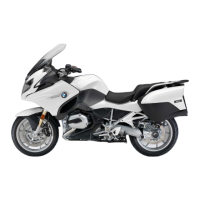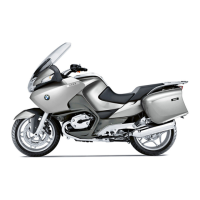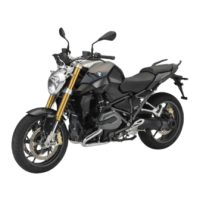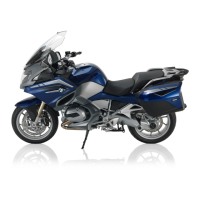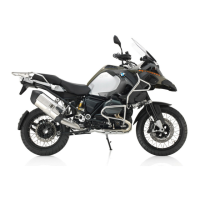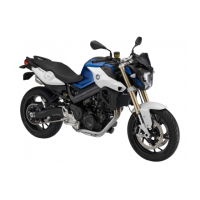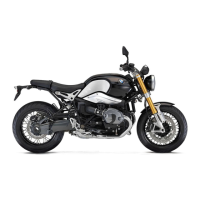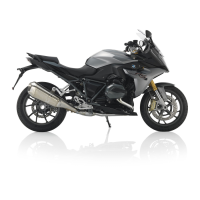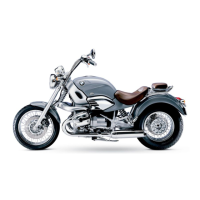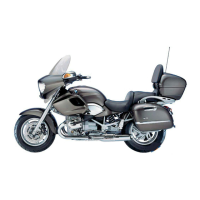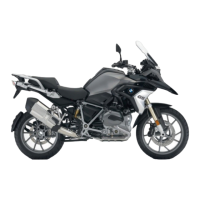Do you have a question about the BMW R 1200RT 2015 and is the answer not in the manual?
Provides a quick orientation to the manual and motorcycle features.
Explains standard abbreviations and symbols used throughout the manual.
Details optional equipment (OE) and accessories (OA) described in the manual.
Lists specifications like dimensions, weights, and performance data.
Advises on potential variations due to ongoing development and country-specific differences.
Identifies components on the left and right sides of the motorcycle.
Shows components located under the rider's seat.
Details the functions of left and right handlebar multifunction switches.
Explains the layout and functions of the motorcycle's instrument cluster.
Explains the various warning and indicator lights on the instrument panel.
Details the information shown on the motorcycle's multifunction display.
Provides a guide to understanding various symbols shown on the display.
Lists and explains specific warning lights and their meanings.
Covers starting the engine, locking the handlebars, and keyless operation.
Explains how to navigate menus and use the onboard computer.
Explains operation of headlights, signals, and hazard flashers.
Covers selecting riding modes and using the cruise control system.
Details adjusting spring preload, damping, and electronic suspension.
Covers adjusting controls, checking tires, and operating heating systems.
Details adjustment and use of mirrors, windshield, and storage compartments.
Explains operation of the central locking and anti-theft alarm system.
Covers rider and passenger seat adjustment and removal.
Emphasizes rider safety, proper clothing, and load distribution.
Discusses speed limits, tire types, and road hazards.
Outlines pre-ride checks, starting procedures, and system self-diagnoses.
Covers engine break-in procedures and gear shifting with assistance.
Explains braking techniques and parking procedures.
Details fuel specifications, refueling procedures, and securing the motorcycle for transport.
Explains riding modes and electronic suspension adjustment.
Details the operation and benefits of the gear shift assistance system.
Explains the function and operation of the hill start assist system.
Covers how the ABS system works and its features.
Explains the Automatic Stability Control system and its functions.
Details the function and operation of the tire pressure monitoring system.
Covers general maintenance procedures and the standard tool kit.
Details checking and topping up engine oil and coolant levels.
Covers checking brake operation, pad thickness, and fluid levels.
Covers checking clutch function and wheel rims/tires.
Step-by-step guides for front and rear wheel removal and installation.
Covers muffler removal/mounting and front wheel stand usage.
Instructions for replacing low-beam, high-beam, parking, and tail lights.
Covers battery maintenance, charging, and jump-starting procedures.
Explains fuse replacement and provides fuse assignments.
Guidelines for using accessories and approved parts.
Details connection and usage of onboard power sockets.
Covers installing, operating, and securing the navigation device.
Instructions for opening, closing, removing, and mounting the motorcycle cases.
Details opening, closing, removing, and mounting the topcase.
Recommends products and provides washing instructions.
Details cleaning procedures for plastics, chrome, and radiator.
Covers care for rubber parts, paint protection, and storage.
Instructions for preparing the motorcycle after storage.
Lists common problems and their possible causes and remedies.
Specifies torque values and key engine data.
Details fuel quality, capacities, and transmission specifications.
Details suspension types and brake system specifications.
Covers tire recommendations and wheel specifications.
Details fuse box assignments, battery specs, and spark plugs.
Covers frame design, alarm system, and vehicle dimensions.
Lists vehicle weights and performance specifications.
Procedure for reporting vehicle safety defects.
Information on dealer network and service quality.
Details roadside assistance and breakdown services.
Outlines the recommended service intervals and tasks.
Lists specific maintenance tasks included in a standard service.
Forms for recording service and maintenance work.
FCC approval details for the ring aerial and immobilizer system.
Declarations of conformity for the remote central locking system.
FCC and IC compliance for the Keyless Ride ID device.
FCC and IC compliance for the Tire Pressure Control system.
Provides a quick orientation to the manual and motorcycle features.
Explains standard abbreviations and symbols used throughout the manual.
Details optional equipment (OE) and accessories (OA) described in the manual.
Lists specifications like dimensions, weights, and performance data.
Advises on potential variations due to ongoing development and country-specific differences.
Identifies components on the left and right sides of the motorcycle.
Shows components located under the rider's seat.
Details the functions of left and right handlebar multifunction switches.
Explains the layout and functions of the motorcycle's instrument cluster.
Explains the various warning and indicator lights on the instrument panel.
Details the information shown on the motorcycle's multifunction display.
Provides a guide to understanding various symbols shown on the display.
Lists and explains specific warning lights and their meanings.
Covers starting the engine, locking the handlebars, and keyless operation.
Explains how to navigate menus and use the onboard computer.
Explains operation of headlights, signals, and hazard flashers.
Covers selecting riding modes and using the cruise control system.
Details adjusting spring preload, damping, and electronic suspension.
Covers adjusting controls, checking tires, and operating heating systems.
Details adjustment and use of mirrors, windshield, and storage compartments.
Explains operation of the central locking and anti-theft alarm system.
Covers rider and passenger seat adjustment and removal.
Emphasizes rider safety, proper clothing, and load distribution.
Discusses speed limits, tire types, and road hazards.
Outlines pre-ride checks, starting procedures, and system self-diagnoses.
Covers engine break-in procedures and gear shifting with assistance.
Explains braking techniques and parking procedures.
Details fuel specifications, refueling procedures, and securing the motorcycle for transport.
Explains riding modes and electronic suspension adjustment.
Details the operation and benefits of the gear shift assistance system.
Explains the function and operation of the hill start assist system.
Covers how the ABS system works and its features.
Explains the Automatic Stability Control system and its functions.
Details the function and operation of the tire pressure monitoring system.
Covers general maintenance procedures and the standard tool kit.
Details checking and topping up engine oil and coolant levels.
Covers checking brake operation, pad thickness, and fluid levels.
Covers checking clutch function and wheel rims/tires.
Step-by-step guides for front and rear wheel removal and installation.
Covers muffler removal/mounting and front wheel stand usage.
Instructions for replacing low-beam, high-beam, parking, and tail lights.
Covers battery maintenance, charging, and jump-starting procedures.
Explains fuse replacement and provides fuse assignments.
Guidelines for using accessories and approved parts.
Details connection and usage of onboard power sockets.
Covers installing, operating, and securing the navigation device.
Instructions for opening, closing, removing, and mounting the motorcycle cases.
Details opening, closing, removing, and mounting the topcase.
Recommends products and provides washing instructions.
Details cleaning procedures for plastics, chrome, and radiator.
Covers care for rubber parts, paint protection, and storage.
Instructions for preparing the motorcycle after storage.
Lists common problems and their possible causes and remedies.
Specifies torque values and key engine data.
Details fuel quality, capacities, and transmission specifications.
Details suspension types and brake system specifications.
Covers tire recommendations and wheel specifications.
Details fuse box assignments, battery specs, and spark plugs.
Covers frame design, alarm system, and vehicle dimensions.
Lists vehicle weights and performance specifications.
Procedure for reporting vehicle safety defects.
Information on dealer network and service quality.
Details roadside assistance and breakdown services.
Outlines the recommended service intervals and tasks.
Lists specific maintenance tasks included in a standard service.
Forms for recording service and maintenance work.
FCC approval details for the ring aerial and immobilizer system.
Declarations of conformity for the remote central locking system.
FCC and IC compliance for the Keyless Ride ID device.
FCC and IC compliance for the Tire Pressure Control system.
| Displacement | 1170 cc |
|---|---|
| Torque | 125 Nm at 6, 500 rpm |
| Curb Weight | 274 kg |
| Fuel System | Electronic fuel injection |
| Cooling System | Air/liquid-cooled |
| Final Drive | Shaft drive |
| Front Tire | 120/70 ZR17 |
| Rear Tire | 180/55 ZR17 |
| ABS | Standard |
| Power | 125 hp at 7, 750 rpm |
| Transmission | 6-speed |
| Fuel Capacity | 25 liters |
| Seat Height | 805/825 mm (adjustable) |
| Front Suspension | Telelever fork |
| Rear Suspension | Paralever swingarm |
| Front Brakes | Dual 320 mm discs, 4-piston calipers |
| Rear Brakes | Single 276 mm disc, 2-piston caliper |
| Engine Type | Air/liquid-cooled, four-stroke, flat twin |
